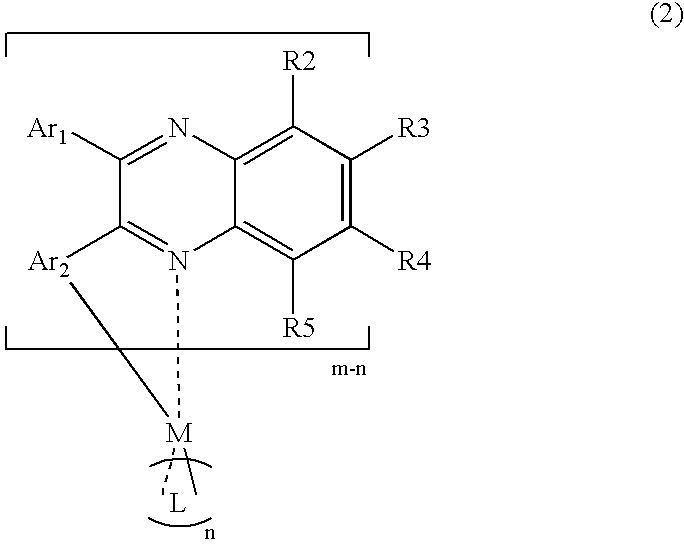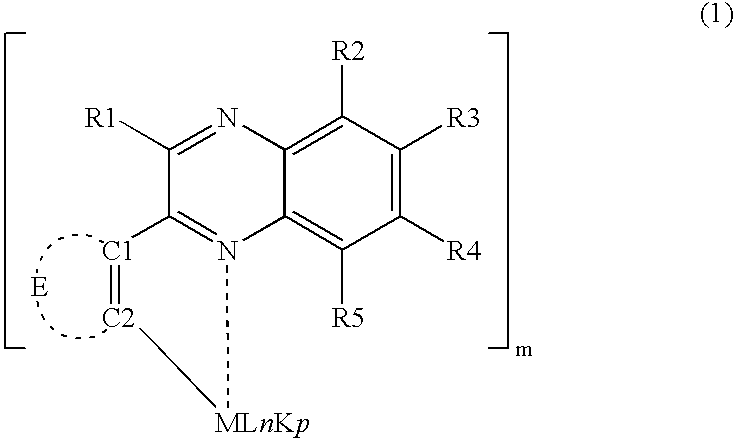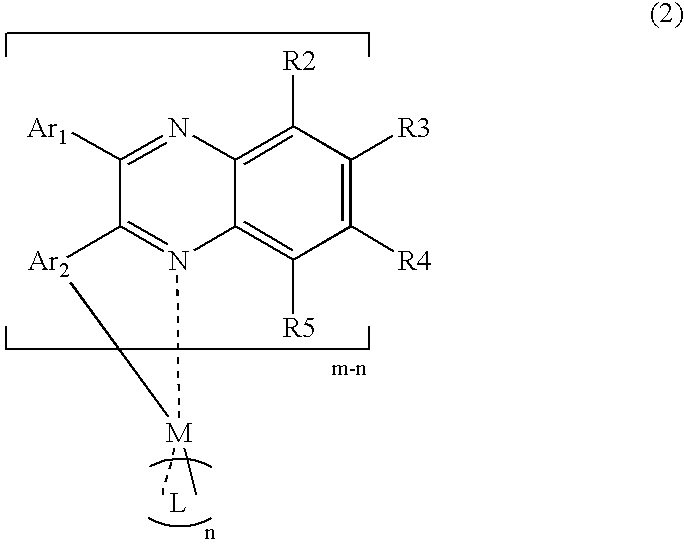Organometallic compound containing quinoxaline structure and light emitting element
a quinoxaline and organic compound technology, applied in organic chemistry, indium organic compounds, natural mineral layered products, etc., can solve the problems of insufficient emitting properties and low emitting efficiency, and achieve excellent light emitting efficiency and light emitting ef ficiency, and achieve excellent both light emitting efficiency and emitting color properties.
- Summary
- Abstract
- Description
- Claims
- Application Information
AI Technical Summary
Benefits of technology
Problems solved by technology
Method used
Image
Examples
synthetic example 1
(i) Synthesis of 2,3-diphenylquinoxaline (quinoxaline derivative [18a])
[0029]
[0030] According to Synthetic Scheme 3, 1,2-phenylenediamine (2.428 g, 22.4 mmol) and benzil (4.721 g, 22.4 mmol) were heated to reflux for 24 hours in ethanol solvent (50 mL). After the reaction mixture was cooled to room temperature, 100 mL of water was added, the precipitates were filtered, the filtered solid was recrystallized from hot ethanol to obtain 2,3-diphenylquinoxaline [18a] (5.463 g, yield 86%) as a colorless needle crystal. This compound was analyzed, and the following results were obtained. m.p. 122° C.;
[0031] Infrared analysis result (KBr, cm−1): 3056, 3027, 1540, 1442, 1348, 1226, 1142, 1076, 978, 929, 770, 731, 697, 598, 538;
[0032]1H NMR (CDCl3, 300 MHz): δ [ppm]: 7.32-7.38 (m, 6H) 7.51-7.54 (m, 4H), 7.78 (dd, J=3.4, 6.3 Hz, 2H), 8.19 (dd, J=3.4, 6.3 Hz, 2H);
[0033]13C NMR (CDCl3, 75.5 MHz): δ [ppm]: 128.2, 128.7, 129.1, 129.7, 129.8, 138.9, 141.1, 153.3;
[0034] Theoretical value from e...
synthetic example 2
(i) Synthesis of 2,3-bis(4-fluorophenyl)quinoxaline [18b]
[0054]
[0055] 1,2-Phenylenediamine (1.214 g, 11.2 mmol) and 4,4′-difluorobenzyl (2.758 g, 11.2 mmol) were heated to reflux in ethanol solvent (50 mL) for 24 hours. After the reaction mixture was cooled to room temperature, 50 mL of water was added, precipitates were filtered, and the filtered solid was recrystallized from hot ethanol to obtain 2,3-bis(4-fluorophenyl)quinoxaline [18b] (3.421 g,yield 96%) as a colorless needle crystal. This compound was analyzed, and the following results were obtained. m.p.:132° C.;
[0056] Infrared analysis result (KBr, cm−1): 3075, 3060, 1602, 1513, 1478, 1393, 1345, 1225, 1161, 1129, 1095, 1054, 1014, 980, 853, 840, 812, 764, 730, 664, 592, 543, 527;
[0057]1H NMR (CDCl3, 300 MHz): δ [ppm]: 7.06 (t, J=8.9 Hz, 2H), 7.51 (dd, J=8.9, 5.8 Hz, 2H), 7.79 (dd, J=6.4, 3.6 Hz, 2H), 8.16 (dd, J=6.4, 3.6 Hz, 2H);
[0058]13CNMR (CDCl3, 75.5 MHz): δ [ppm]:115.5 (J13C-19F=22 Hz), 129.0, 130.1, 131.7 (J13C-19F...
synthetic example 3
(i) Synthesis of 2,3-bis(4-methylphenyl)quinoxaline [18c]
[0075]
[0076] 1,2-Phenylenediamine (2.163 g, 20.0 mmol) and 4,4′-dimethylbenzyl (4.766 g, 20.0 mmol) were heated to reflux in ethanol solvent (50 mL) for 24 hours. After the reaction mixture was cooled to room temperature, 100 mL of water was added, precipitates were filtered, and the filtrated solid was dried under reduced pressure at 100° C. for 4 hours to obtain 2,3-bis(4-methylphenyl)quinoxaline [18c](5.972 g, yield 96%) as a colorless needle crystal. This compound was analyzed, and the following results were obtained. m.p.:149° C.;
[0077] Infrared analysis result (KBr, cm−1): 3030, 2969, 2913, 2863, 1612, 1556, 1514, 1475, 1409, 1394, 1344, 1308, 1280, 1249, 1223, 1213, 1186, 1142, 1110, 1056, 1020, 977, 965, 951, 832, 820, 761, 723, 607, 594, 546, 528;
[0078]1H NMR (CDCl3, 300 MHz): δ [ppm]: 2.37 (s, 3H, CH3), 7.14 (d, J=7.8 Hz, 2H), 7.43 (d, J=7.8 Hz, 2H), 7.74 (dd, J=3.4, 6.4 Hz, 2H), 8.15 (dd, J=3.4, 6.4 Hz, 2H);
[0079...
PUM
| Property | Measurement | Unit |
|---|---|---|
| temperature | aaaaa | aaaaa |
| emitting peak wavelength | aaaaa | aaaaa |
| luminance | aaaaa | aaaaa |
Abstract
Description
Claims
Application Information
 Login to View More
Login to View More - R&D
- Intellectual Property
- Life Sciences
- Materials
- Tech Scout
- Unparalleled Data Quality
- Higher Quality Content
- 60% Fewer Hallucinations
Browse by: Latest US Patents, China's latest patents, Technical Efficacy Thesaurus, Application Domain, Technology Topic, Popular Technical Reports.
© 2025 PatSnap. All rights reserved.Legal|Privacy policy|Modern Slavery Act Transparency Statement|Sitemap|About US| Contact US: help@patsnap.com



